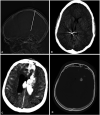Surviving the Scene in Civilian Penetrating Brain Injury: Injury Type, Cause and Outcome in a Consecutive Patient Series in Austria
- PMID: 35836601
- PMCID: PMC9274525
- DOI: 10.3389/fsurg.2022.923949
Surviving the Scene in Civilian Penetrating Brain Injury: Injury Type, Cause and Outcome in a Consecutive Patient Series in Austria
Abstract
Background: Penetrating brain injury (PBI) is a heterogeneous condition with many variables. Few data exist on civilian PBI. In some publications, PBI differentiation between low-velocity injury (LVI) and high-velocity injury (HVI) is made, but exact definitions are not given yet. The incidence of PBI depends heavily on the country of origin. Furthermore, captive bolt pistol (CBP) injuries represent a rare type of LVI and almost no reports exist in the human medical literature. Treatment of PBI has been controversially discussed due to high morbidity and mortality with results varying considerably between series. Prognostic factors are of utmost importance to identify patients who presumably benefit from treatment.
Methods: A retrospective, single-center analysis of a consecutive patient series was performed from September 2005 to May 2018. We included all patients with PBI who reached our hospital alive and received any neurosurgical operative procedure.
Results: Of 24 patients, 38% died, 17% had an unfavourable outcome, and 46% had a favourable outcome. In total, 58% of patients with PBI were self-inflicted. Leading causes of injury were firearms, while captive bolt pistols were responsible for 21% of injuries. LVI represented 54%, and HVI represented 46%. The outcome in HVI was significantly worse than that in LVI. A favourable outcome was achieved in 69% of LVI and 18% of HVI. Low GCS and pathological pupillary status at admission correlated significantly with an unfavourable outcome and death.
Conclusions: PBI is a heterogeneous injury with many variables and major geographical and etiological differences. Differentiation between LVI and HVI is crucial for decision-making and predicting outcomes. In patients presenting with object trajectories crossing the midline, no favourable outcome could be achieved. Nevertheless, in total, a favourable outcome was possible in almost half of the patients who succeeded in surgery.
Keywords: firearm injury; high velocity; low velocity; penetrating brain injury; traumatic brain injury.
Copyright © 2022 Marhold, Scheichel, Ladisich, Pruckner, Strasser, Themesl, Ungersboeck and Popadic.
Conflict of interest statement
The authors declare that the research was conducted in the absence of any commercial or financial relationships that could be construed as a potential conflict of interest.
Figures


Similar articles
-
Ballistic lobar trajectory outcomes in civilian firearm penetrating brain injury.J Neurosurg. 2020 Nov 6;135(2):574-583. doi: 10.3171/2020.6.JNS201837. Print 2021 Aug 1. J Neurosurg. 2020. PMID: 33157538
-
Civilian Firearm-Inflicted Brain Injury: Coagulopathy, Vascular Injuries, and Triage.Curr Neurol Neurosci Rep. 2021 Jul 10;21(9):47. doi: 10.1007/s11910-021-01131-0. Curr Neurol Neurosci Rep. 2021. PMID: 34244864 Review.
-
Comparative Analysis of Clinical Severity and Outcomes in Penetrating Versus Blunt Traumatic Brain Injury Propensity Matched Cohorts.Neurotrauma Rep. 2024 Apr 3;5(1):348-358. doi: 10.1089/neur.2024.0009. eCollection 2024. Neurotrauma Rep. 2024. PMID: 38595793 Free PMC article.
-
Analysis of ballistic trajectories and its association with clinical outcomes in civilian penetrating brain injury.Eur J Trauma Emerg Surg. 2024 Oct;50(5):2527-2537. doi: 10.1007/s00068-024-02643-3. Epub 2024 Sep 9. Eur J Trauma Emerg Surg. 2024. PMID: 39249526 Free PMC article.
-
Perioperative Care for Pediatric Patients With Penetrating Brain Injury: A Review.J Neurosurg Anesthesiol. 2018 Oct;30(4):290-298. doi: 10.1097/ANA.0000000000000441. J Neurosurg Anesthesiol. 2018. PMID: 28538329 Review.
Cited by
-
Captive Bolt Gun-Related Vascular Injury: A Single Center Experience.Diagnostics (Basel). 2024 May 8;14(10):977. doi: 10.3390/diagnostics14100977. Diagnostics (Basel). 2024. PMID: 38786275 Free PMC article.
-
Bolt gun injury to central forehead, sagittal sinus and frontal lobes: A case report.Int J Surg Case Rep. 2025 Aug;133:111559. doi: 10.1016/j.ijscr.2025.111559. Epub 2025 Jun 22. Int J Surg Case Rep. 2025. PMID: 40554933 Free PMC article.
-
Particular Surgical Technique for Transorbital-Penetrating Craniocerebral Injury Inflicted by a Screwdriver: Technical Case Report.Korean J Neurotrauma. 2023 Aug 2;19(3):356-362. doi: 10.13004/kjnt.2023.19.e35. eCollection 2023 Sep. Korean J Neurotrauma. 2023. PMID: 37840617 Free PMC article.
-
Civilian penetrating traumatic brain injury: A 5-year single-center experience.Surg Neurol Int. 2023 Jan 27;14:28. doi: 10.25259/SNI_1160_2022. eCollection 2023. Surg Neurol Int. 2023. PMID: 36895251 Free PMC article.
References
-
- Solumsmoen S, Lilja-Cyron A, Fugleholm Buch K, Kelsen J. Penetrerende hovedtraume med hjernelaesion. Ugeskr Læger. (2018) 180:2–6. http://ugeskriftet.dk/files/scientific_article_files/2018-12/v03180201_1...
LinkOut - more resources
Full Text Sources

